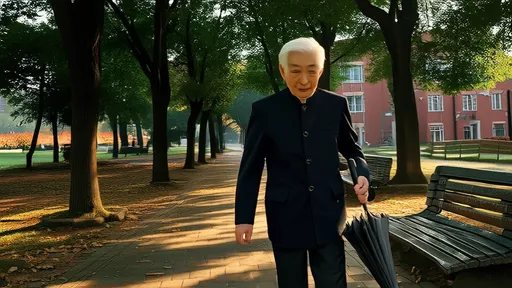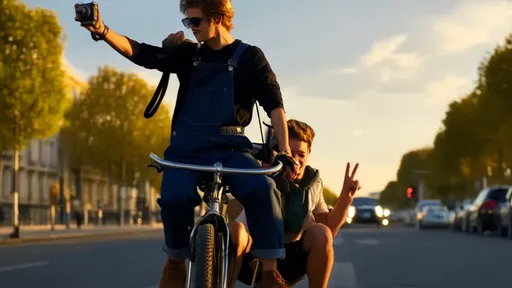The rhythmic click of the freewheel, the occasional wobble of handlebars, and the unspoken tension in your thighs as you perch on the back of a bicycle built for two – few experiences distill the essence of trust quite like riding tandem. Bicycle协作, or bicycle cooperation as it's sometimes translated, isn't merely about sharing pedals; it's a moving meditation on vulnerability and surrender set against the blur of passing scenery.
From behind the captain (the front rider), the stoker (rear rider) enjoys a peculiar vantage point – all momentum, no control. Your world narrows to the arc of your partner's shoulders, the tilt of their helmet indicating an upcoming turn. You learn to read their body like a nautical chart, sensing hesitation in the set of their spine or confidence in the pressure of their calves against yours. This is intimacy of the most pragmatic sort: your safety depends on their competence, your comfort on their anticipation of road conditions you cannot yet see.
Modern cycling culture often celebrates independence – the solo rider conquering alpine passes or urban jungles. Yet the tandem bicycle, that Victorian-era relic, persists as a counterpoint. Dating back to 1898's "The Bicycle Built for Two" song, these machines demand what psychologist call dyadic attunement – the continuous, subconscious synchronization between partners. Studies from sports science journals reveal that experienced tandem teams develop coupled movement patterns indistinguishable from individual riders, their pedal strokes entraining like cardiac muscle cells in vitro.
The rear seat teaches brutal honesty about one's capacity for trust. Novice stokers often report gripping the handlebars until their knuckles bleach, instinctively braking against phantom pedals – actions that actually destabilize the bike. Seasoned riders describe a moment of revelation when they finally stop steering with their panic and let the captain's decisions flow through their own limbs. This surrender isn't passive; it's an active calibration of vigilance and relaxation that mirrors the balance required in any profound partnership.
Urban planners in Copenhagen have experimented with tandem bike-sharing programs as tools for social cohesion. The preliminary findings suggest that strangers who complete errands together on these bikes demonstrate higher levels of oxytocin – the so-called "trust hormone" – compared to those who interact in stationary settings. There's something about shared forward motion, the necessity of leaning into curves together, that accelerates bonding. As one participant remarked: "You can't hate someone when your thighs keep touching."
Technological innovations are reshaping this ancient trust exercise. E-tandems with independent pedal assist systems allow mismatched fitness levels to ride harmoniously, while haptic feedback handlebars let captains communicate turns through vibration patterns. Yet purists argue these advancements miss the point – the magic lies in the raw, unmediated transmission of intention from one body to another. The slight counterlean of a stoker anticipating the captain's turn creates a feedback loop more sophisticated than any sensor array.
Perhaps the tandem's greatest lesson is that trust isn't binary. It's not simply given or withheld, but constantly negotiated through microadjustments – a pressure here, a yielding there. The bicycle becomes a truth-telling machine, revealing where we cling to illusory control and where we're ready to move in concert with another. In an age of algorithmic isolation, the simple act of propelling forward together, breath synced to the same cadence, might be the most radical form of connection left to us.
Workshops now offered from Berlin to Kyoto use tandem cycling as team-building exercises for corporate groups. The results often surprise participants – CFOs who dominate board meetings find themselves white-knuckled on the backseat, while junior staffers discover unexpected leadership skills as captains. The bicycle doesn't care about org charts; it responds only to the quality of the partnership in that moment. As one facilitator observed: "No one can fake competence on a tandem. The bike knows."
From Dutch couples navigating grocery runs to visually impaired athletes competing in Paralympic events, the tandem continues to reinvent itself while preserving its core function – making visible the invisible threads of trust that bind us. The next time you see one gliding by, notice the subtle dance of adjustments between riders. That's no mere transportation; it's philosophy in motion, a two-person manifesto on how we might navigate this world together.

By /Jul 15, 2025

By /Jul 15, 2025

By /Jul 15, 2025

By /Jul 15, 2025

By /Jul 15, 2025

By /Jul 15, 2025

By /Jul 15, 2025

By /Jul 15, 2025

By /Jul 15, 2025

By /Jul 15, 2025

By /Jul 15, 2025

By /Jul 15, 2025

By /Jul 15, 2025

By /Jul 15, 2025

By /Jul 15, 2025

By /Jul 15, 2025

By /Jul 15, 2025

By /Jul 15, 2025